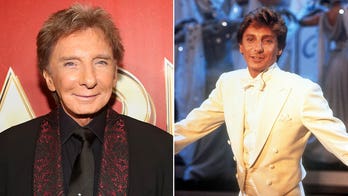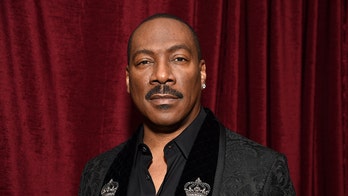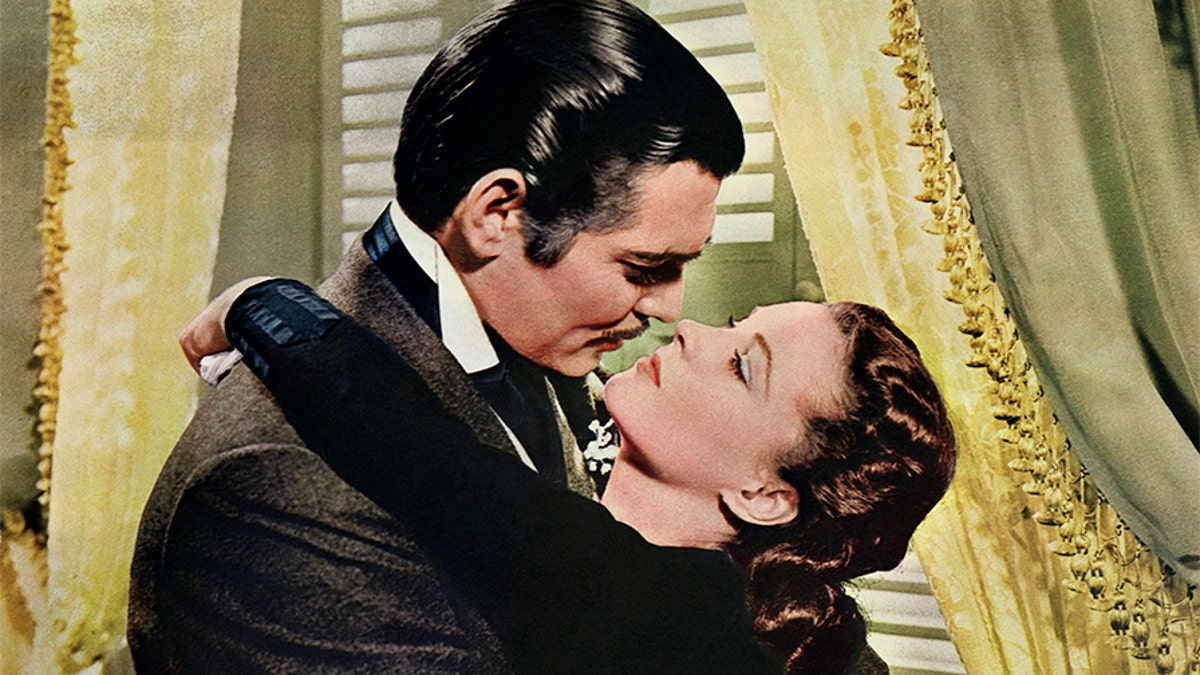
Rhett Butler (Clark Gable) embraces Scarlett O'Hara (Vivien Leigh) in a famous scene from the 1939 epic film "Gone with the Wind." — Getty
Vivien Leigh captivated the world with her iconic performance as Scarlett O’Hara in 1939’s “Gone with the Wind,” along with her real-life romance with actor Sir Laurence Olivier. But behind closed doors, the Hollywood star suffered from mental illness and a devastating miscarriage that may have contributed to her breakdown.
Biographer Alan Strachan recently wrote the book “Dark Star,” which examines the life of one of the most celebrated actresses of the 20th century. Strachan studied secret letters between Leigh and Olivier, diary entries, as well as tracked down some of the last living people who both worked and befriended her over the years.
FORMER '50S STAR BARBARA PAYTON ENDURED A TRAGIC DOWNFALL
Leigh died in 1967 at age 53 from tuberculosis.
It is believed the India-born British actress suffered from bipolar disorder during a time the illness wasn’t as widely discussed as it is today. According to Strachan’s research, the first signs of the condition may have shown in her childhood, after she was sent away to a convent school at age 6 in London.
“Even at school, some of her schoolmates did notice periods when she would withdraw, almost inside herself, and occasionally be almost hysterical for a brief period," Strachan told Fox News. "Then she would relax and become absolutely normal again and her usual cheery self.”
In 1932, Leigh married attorney Herbert Leigh Holman and the couple shared one child, a daughter named Suzanne. According to reports, Leigh first met Olivier, who was married to actress Jill Esmond, in 1936, after one of her stage performances in London. An all-consuming affair reportedly began a year later.
IDA LUPINO WAS A RECLUSE IN HER FINAL YEARS
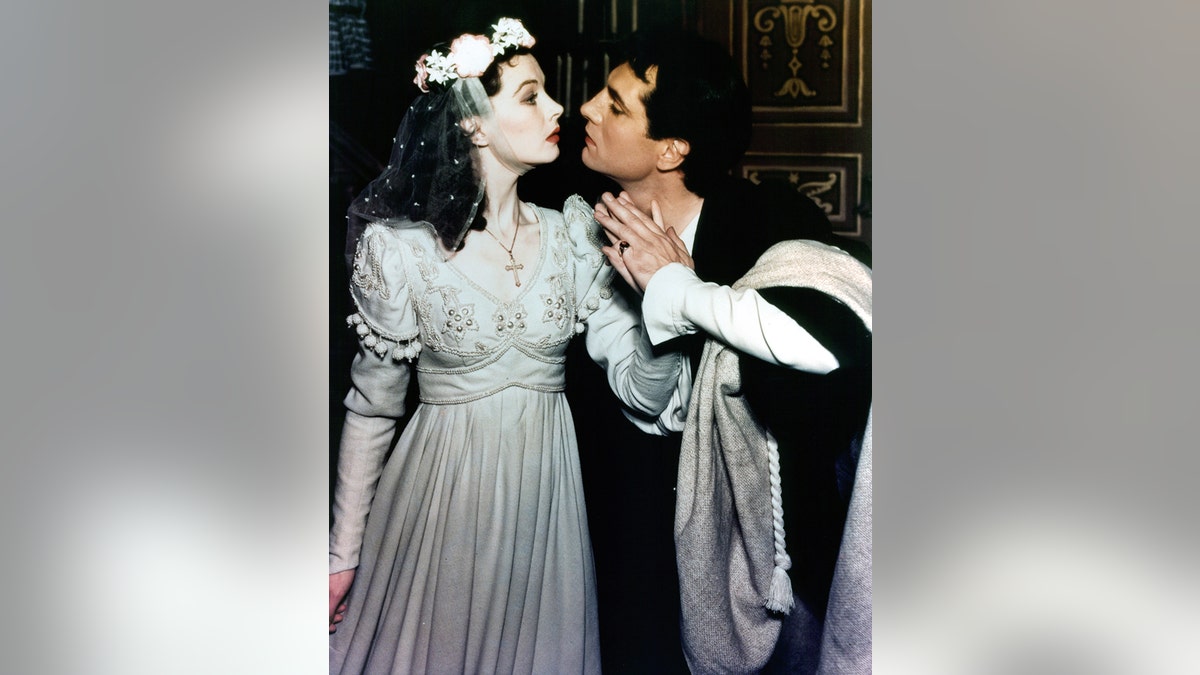
Vivien Leigh prepares to kiss Laurence Olivier in a scene from a stage production of "Romeo and Juliet," 1940. (Getty)
“In their letters, it’s perfectly clear that the romance was hot as hellfire,” said Strachan. “They… couldn’t keep their hands off each other.”
Esmond couldn’t ignore the undeniable chemistry between the pair, especially after Leigh “coincidentally” showed up in Capri, Italy during their family vacation. It was then that Esmond reportedly realized she just couldn’t fight the not-so-secret affair.
Leigh and Olivier ultimately tied the knot in 1940, the same year they divorced their spouses. But by then, Leigh reportedly suffered from frequent mood swings, which ultimately led to a reputation of her being unreasonable and even difficult to work with. Leigh, by then an established actress, was hesitant to visit a psychiatrist out of fear that it would ruin her blossoming career.
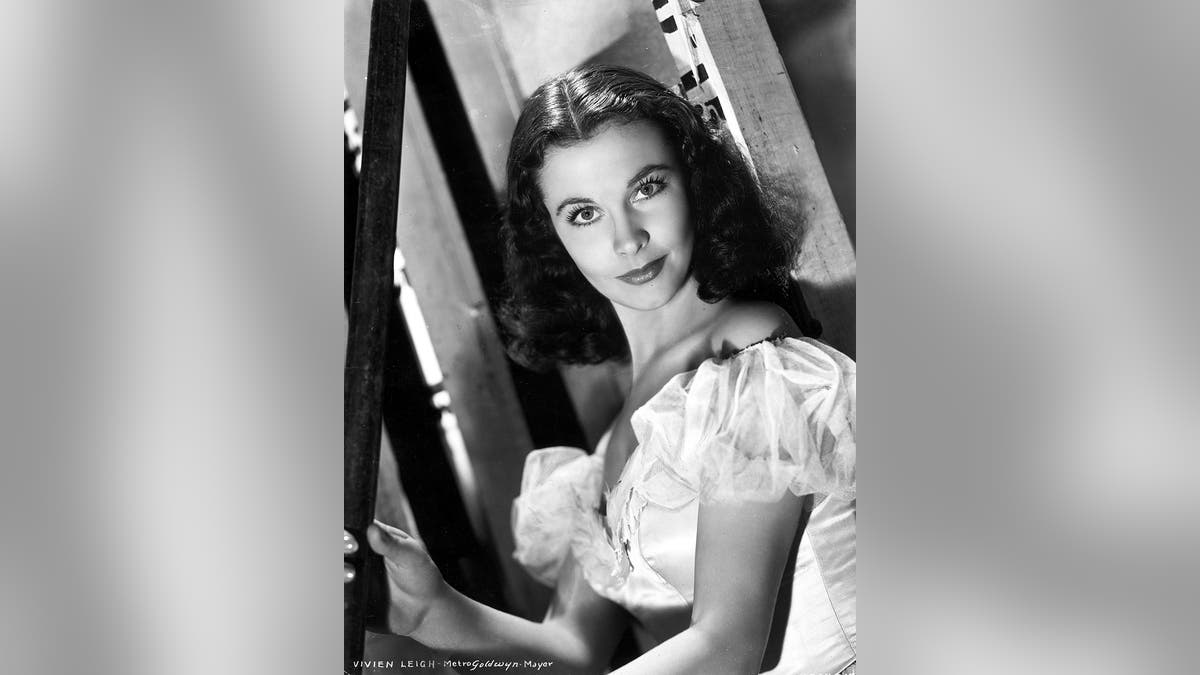
Vivien Leigh privately battled with mental illness in her lifetime. (Getty)
RITA HAYWORTH'S DAUGHTER TELLS ALL
“It took some persuasion to take her to see a psychiatrist, which she did, but it led nowhere,” said Strachan. “Vivien was terrified of the publicity that might possibly be shaken out by that. She was near hysterical at the thought of having anything about her nervous condition appearing in the newspapers. It was considered something of a stigma at that time.”
“Her own mother could never accept it,” he continued. “She never would admit that Vivien suffered from any nervous trouble. She would tell her granddaughter, Vivien’s daughter, if there was an episode of any kind or bipolarity, whether it was a manic phase or a down phase, she would just say, ‘Oh, it’s just artistic temperament.’ That’s how most people regarded it.”
UK’s Spectator shared that Leigh was faced with “episodes” that were greatly misunderstood in her lifetime and likely took a toll on her marriage to Olivier.
“These were moods of intense loneliness and despair, alternating with a wildness which might include running naked through the streets, violent abuse, scorching anger,” claimed the magazine. “Once she bit someone’s finger. Afterwards, she would apologize politely, perhaps not really remembering. Even loyal friends, such as John Gielgud and Noel Coward, did not understand, and some blamed alcohol. After 10 happy, triumphant, years, there were 10 that were more mixed. Both Leigh and Olivier had affairs.”
SALLY FIELD ON HER 'INTENSE' RELATIONSHIP WITH BURT REYNOLDS
Leigh starred in two films that impacted pop culture, “Gone with the Wind” and 1951’s “A Streetcar Named Desire." But despite her growing accomplishments in film alone, Strachan said Leigh’s career was overshadowed by her husband’s. And her sought-after beauty became more of a burden.
“She loathed references to it and just brushed them off,” he explained. “She didn’t like compliments about her beauty. It was kind of a fatal gift, really, this feeling that if you are very beautiful, you can’t possibly have any other attributes, something that applied to quite a lot of people at that time.”
Strachan pointed out that Olivier, like many others, had a difficult time attempting to make sense of Leigh’s questionable behavior. Despite her personal anguish, Leigh kept busy while yearning to have a child with Olivier. Her dream of becoming a mother again ended in tragedy.
“The previous books have said she suffered two miscarriages,” said Strachan. “The research I did makes it pretty clear there were three… She had one that was well documented while filming [1945’s] ‘Caesar and Cleopatra’ … She was only about two months pregnant, but she slipped on a very highly polished marble floor during filming and lost the baby. That definitely had an effect on her.
JAMES DEAN'S FINAL DAYS REVEALED
“There was a period when she returned to the studio to complete filming when she had a very bad outburst which she had no memory of after it was over, but she just went haywire for about half an hour and nobody could control her. I’m mostly convinced that was borne out of bottled disappointment and very deep sadness.”
Leigh was poised to star in 1954’s “Elephant Walk,” but by then, Strachan claimed she was clearly “very disturbed.” Leigh’s symptoms couldn’t be ignored by the cast.
“She managed a month filming in Sri Lanka, although there were stresses during it and she was clearly very high strung at that period,” claimed Strachan. “But then it moved to Hollywood to do its interior shots, and then the trouble really began. That was a nightmare period. She slipped into her worst manic spell to date, absolutely impossible to remember her lines. She kept slipping into past characters. She would start going into Blanche DuBois from ‘A Streetcar Named Desire,’ which she played on stage in London and then onscreen for her second Oscar.”
Leigh was later replaced with Elizabeth Taylor. But her troubles didn’t end there.
VERONICA LAKE, FORMER '40S HOLLYWOOD STAR, APPEARED 'VERY DAMAGED' IN HER LATER YEARS
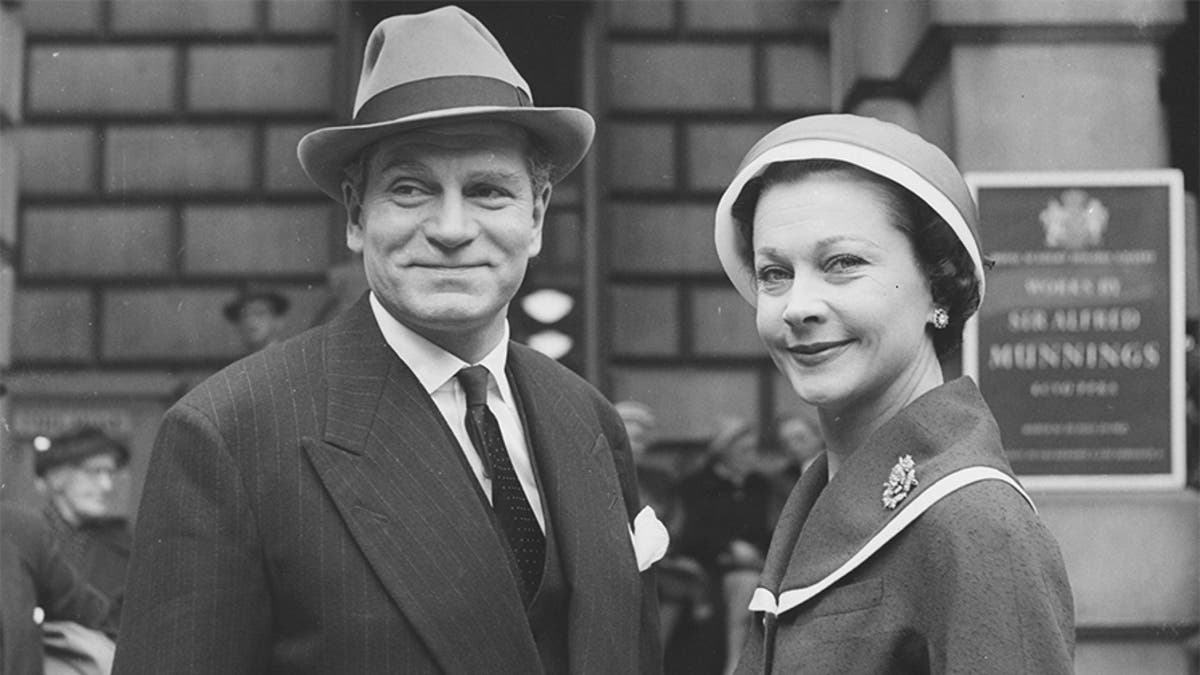
May 1956: English actor and director Sir Laurence Olivier with his second wife, English actress Vivien Leigh. (Getty)
“She was flown back to England to a mental hospital, where she stayed for about three months, and then there was a longer period in another hospital where she received what was really the only seriously considered treatment at that time in England,” claimed Strachan. “It was ECT — electroconvulsive therapy when an electric shock is passed through the sedated patient’s brain. That must have been absolutely horrific for her.”
In 1955, Strachan claimed Leigh became pregnant while rehearsing for a play in London titled “South Sea Bubble.” Eager to focus on her pregnancy, Leigh left the play after three months. However, everything came to an end the next day.
“She kept a little pocket diary… and on that day, the only entry is ‘5 a.m.,’” said Strachan. “… That was the time she began to miscarry that particular baby. The doctor arrived and just couldn’t save the baby…. I think that plunged her into a very, very deep depression and understandably so.”
While faced with the great loss, Leigh also had to endure rumors that she pretended to be pregnant to have the press focus on her, as opposed to blonde bombshell Marilyn Monroe, who arrived in London to film “The Prince and the Showgirl” alongside Olivier. After the miscarriage, Leigh had frequent outbursts directed at her husband and those associated with him.
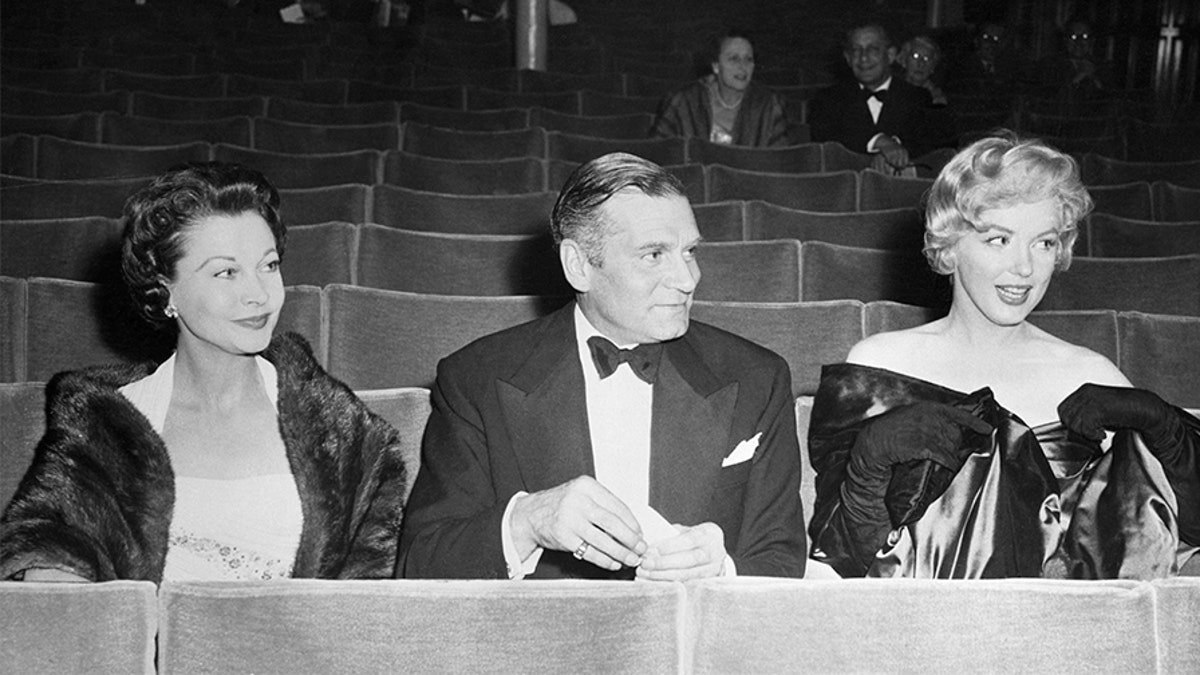
Seated in the stalls of the Comedy Theater for the London premiere of Arthur Miller's play, "A View From the Bridge," are Vivien Leigh, her husband, Sir Laurence Olivier, and Hollywood's Marilyn Monroe, wife of the author. The trio arrived early to avoid the rush. — Getty (Getty)
PATTY DUKE SHARES MEMORIES OF SHARON TATE
The couple divorced in 1961. Olivier went on to marry actress Joan Plowright, who was 22 years younger than him, that same year. The pair had a son and two daughters. Leigh continued to pursue her passion for acting.
“There was no sense that she was giving up on life — far from it,” said Strachan. “She wasn’t that kind of woman. She certainly wasn’t going to retire from the stage.”
Strachan also shared Leigh and Olivier continued to write letters to each other even after their marriage came to an end.
“She never stopped loving him,” he said. “It would have lasted, I’m absolutely convinced, had it not been for the bipolarity, which was at its worst in the second half of their marriage. And he found it impossible to deal with. He couldn’t cope with dealing with Vivien’s bipolarity and looking after his own career, which he was obsessive over… He was sad that the marriage collapsed, but it was inevitable… They were both realists.”
CLICK HERE TO GET THE FOX NEWS APP
Leigh never remarried after Olivier but continued pursuing her passion to act. At the time of her death, she was preparing to start rehearsals for the London stage production of “A Delicate Balance.”
Strachan hopes his book will give new insight on Leigh’s illness, as well as celebrate her work as an actress.
“I think Vivien was very, very undervalued,” he said. “I hope the book, in some ways, has gone towards making it clear that she was a significant performer in her own right, not just an appendage to Laurence Olivier.”



